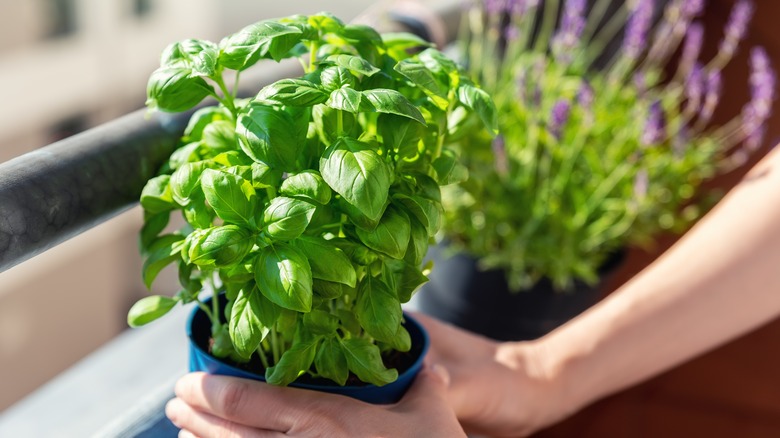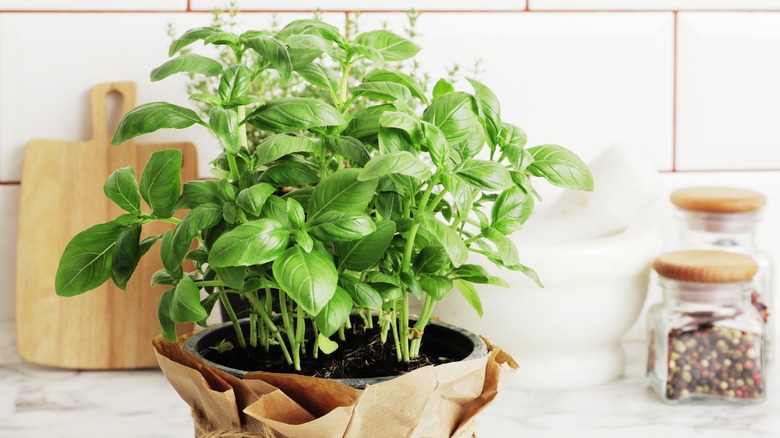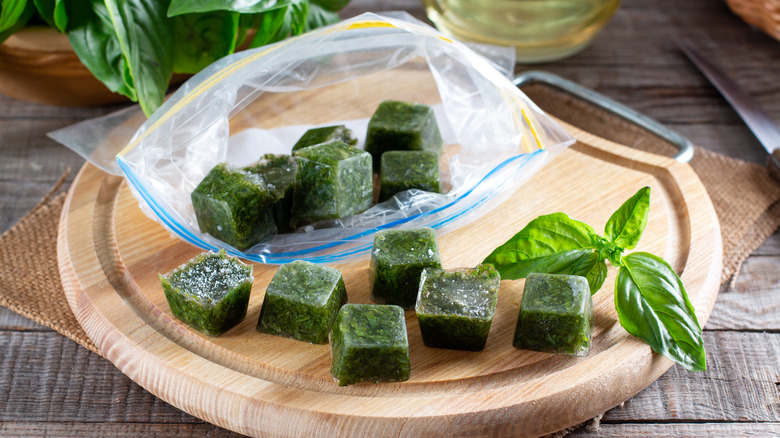The Best Way To Harvest Basil Ensures It Keeps Growing All Summer
Basil is one of the most popular herbs for gardeners and cooks alike. Basil includes diverse cultivars, such as sweet basil, Thai basil, lemon basil, and purple basil, which lend their signature flavors to foods from Southern Europe to Southeast Asia and beyond. The plants are easy to grow in moist, well-drained soil and produce leaves in abundance. If you harvest correctly, they continue to be productive throughout the growing season. For gardeners, it is crucial to note that culinary basil is a warm-weather annual plant. Annual plants grow from seeds each spring and complete their life cycle by flowering and producing seeds before the first frost in fall. A hallmark of annuals, including basil, is that they only produce foliage for a short time.
Once annuals reach maturity, leafy growth slows as they start producing flowers — and, ultimately, seeds. Gardeners can effectively delay the flowering phase by pruning basil consistently throughout the growing season. Gardeners grow basil for their sweet, spicy leaves, so knowing how to pick basil helps the plant keep growing leaves as long as possible. To harvest fresh basil, cut back individual stems or branches above an intersection where side shoots are coming out. Do not leave a long branch stub above this intersection. Regrowth will occur from the side shoots, and the plant will be ready to harvest again within a week or two.
Other tips for harvesting basil
Begin harvesting basil shortly after the seed sprouts and the second set of leaves appear. Until the first flower buds form, the plant will grow lush, tender foliage. Harvest leaves a few at a time at first. Later, clip the stems at the first or second branch intersection below the tips of the branches. Gradually begin to remove up to ⅓ of the leaves every time you harvest, ideally every month. Harvesting leaves during this early stage is necessary to train the plant to grow full and bushy; it also helps delay maturity. The tender leaves you have harvested during this time are excellent in Caprese salads or added to soups and pasta after cooking.
The first flower buds start forming when the plant is above 6 inches tall. Beginning at the budded tips, cut stems back to the third or fourth set of side shoots. Harvest about 30% of the total foliage on plants that have buds. Use these mature fresh leaves for pesto or at the final stage of cooking sauces, soups, and curries. Julie Chai, associate garden editor of Sunset magazine, also suggests that home gardeners remove the flowers from basil plants as they appear. By plucking the flowers, you are keeping the herb in a prepubescent state, which will taste better — and less bitter — than "older" basil. You can also eat basil flowers, but sometimes they can taste bitter. We suggest giving them a nibble first.
How to store fresh basil
At some point, you will likely be harvesting far more fresh basil than you can use. There is no need to let it go to waste: You can preserve basil by freezing or dehydrating it. To freeze the leaves, coarse-grind them in a food processor with a drizzle of olive oil. Then, pack it into an ice cube tray. Remove the frozen basil cubes and store them in a plastic bag for up to six months.
Dry basil either in a food dehydrator or by hanging the washed stems. Hang them in a place with good air circulation, out of direct sunlight, wrap them in paper to keep them clean, crush the dried basil, and store it in a glass jar. There comes a time late in the season when flowering is imminent, and leaf production halts. Let it happen — but don't forget to collect the seeds from your best plants to plant next spring.


